COMM99: Article Review on Animal-Assisted Intervention in Dementia
VerifiedAdded on 2023/06/03
|8
|1475
|478
Report
AI Summary
This article review examines an article focusing on the benefits of animal-assisted intervention for individuals suffering from dementia. The review identifies the thesis, which highlights the positive impact of animal-assisted interventions on the mental well-being of dementia patients, supported by four key ideas: animal involvement, psychosocial benefits, positive effects of dog visits, and the role of nursing staff. The review analyzes the article's bias, organizational structure (report format), and evidence, including scholarly opinions, the importance of animal-assisted intervention, responses from study participants, and result tables. The credibility stems from discussions of research findings and observations of dog handlers. The target audience includes future researchers. The article's purpose is informative, aiming to discuss the advantages of animal assistance, with neutral and direct language. The review provides the APA citation for the article and summarizes its key findings and limitations, emphasizing the need for further research to generalize the results. The study suggests that animal-assisted interventions can provide benefits to the mental health of dementia patients.
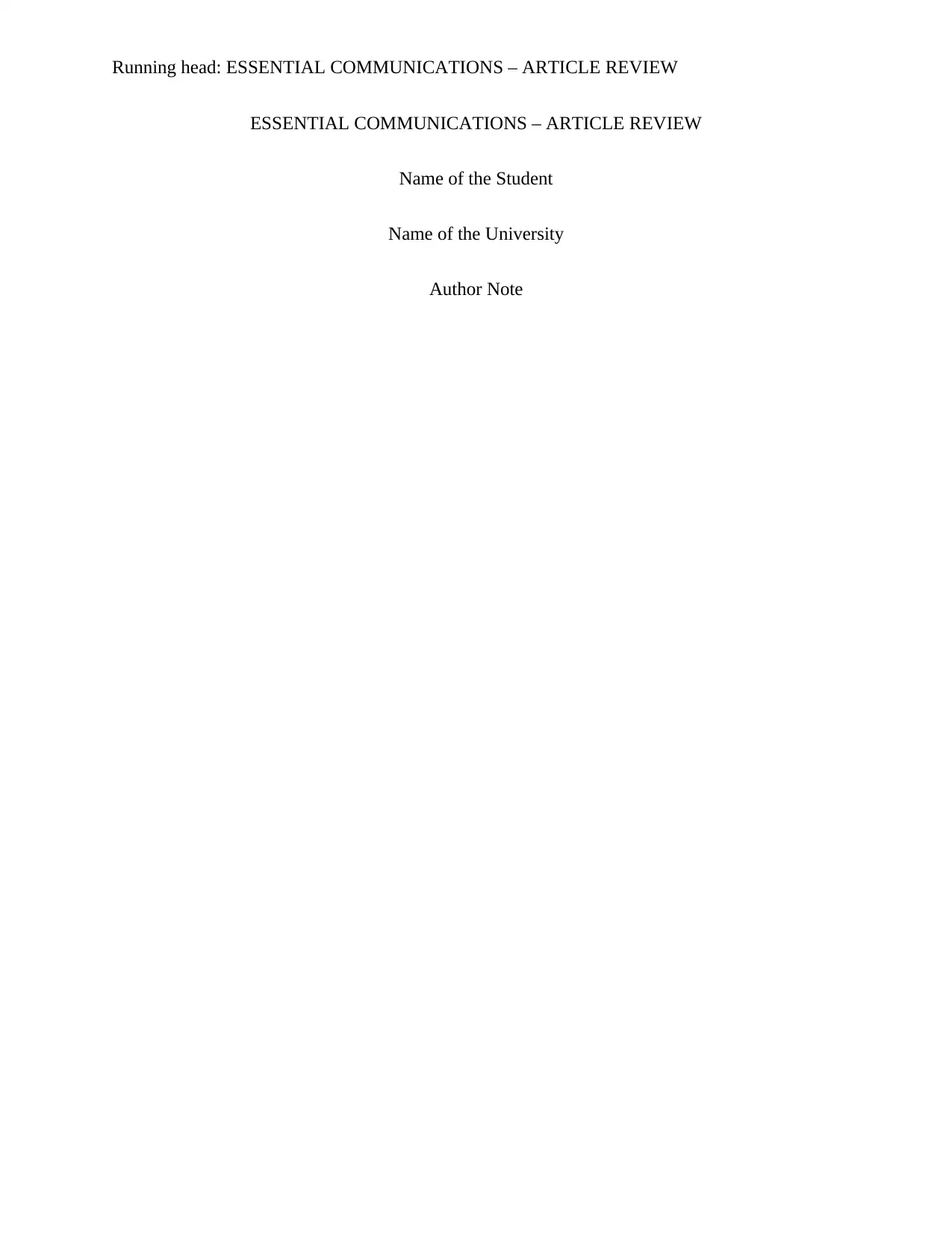
Running head: ESSENTIAL COMMUNICATIONS – ARTICLE REVIEW
ESSENTIAL COMMUNICATIONS – ARTICLE REVIEW
Name of the Student
Name of the University
Author Note
ESSENTIAL COMMUNICATIONS – ARTICLE REVIEW
Name of the Student
Name of the University
Author Note
Paraphrase This Document
Need a fresh take? Get an instant paraphrase of this document with our AI Paraphraser
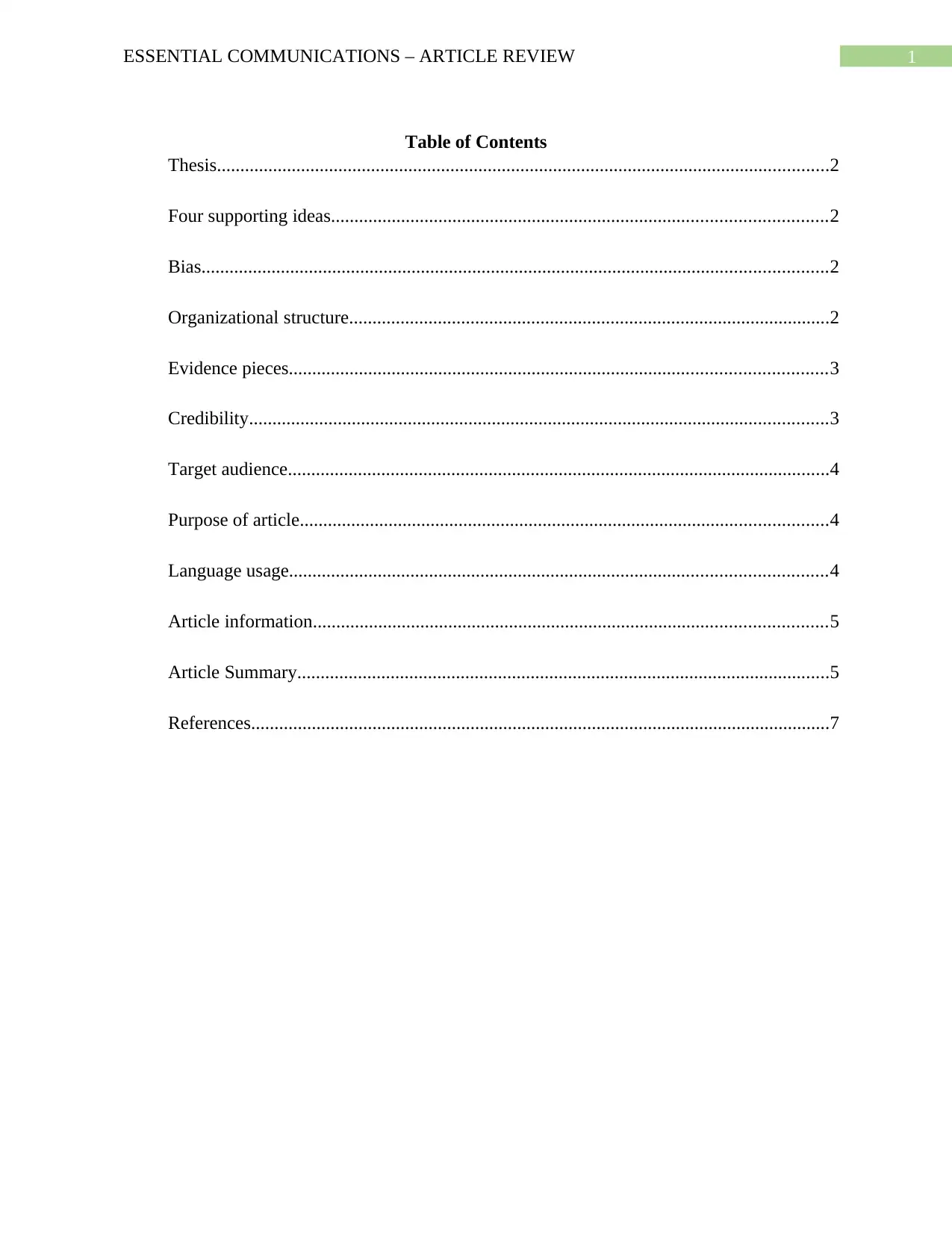
1ESSENTIAL COMMUNICATIONS – ARTICLE REVIEW
Table of Contents
Thesis...................................................................................................................................2
Four supporting ideas..........................................................................................................2
Bias......................................................................................................................................2
Organizational structure.......................................................................................................2
Evidence pieces...................................................................................................................3
Credibility............................................................................................................................3
Target audience....................................................................................................................4
Purpose of article.................................................................................................................4
Language usage...................................................................................................................4
Article information..............................................................................................................5
Article Summary..................................................................................................................5
References............................................................................................................................7
Table of Contents
Thesis...................................................................................................................................2
Four supporting ideas..........................................................................................................2
Bias......................................................................................................................................2
Organizational structure.......................................................................................................2
Evidence pieces...................................................................................................................3
Credibility............................................................................................................................3
Target audience....................................................................................................................4
Purpose of article.................................................................................................................4
Language usage...................................................................................................................4
Article information..............................................................................................................5
Article Summary..................................................................................................................5
References............................................................................................................................7
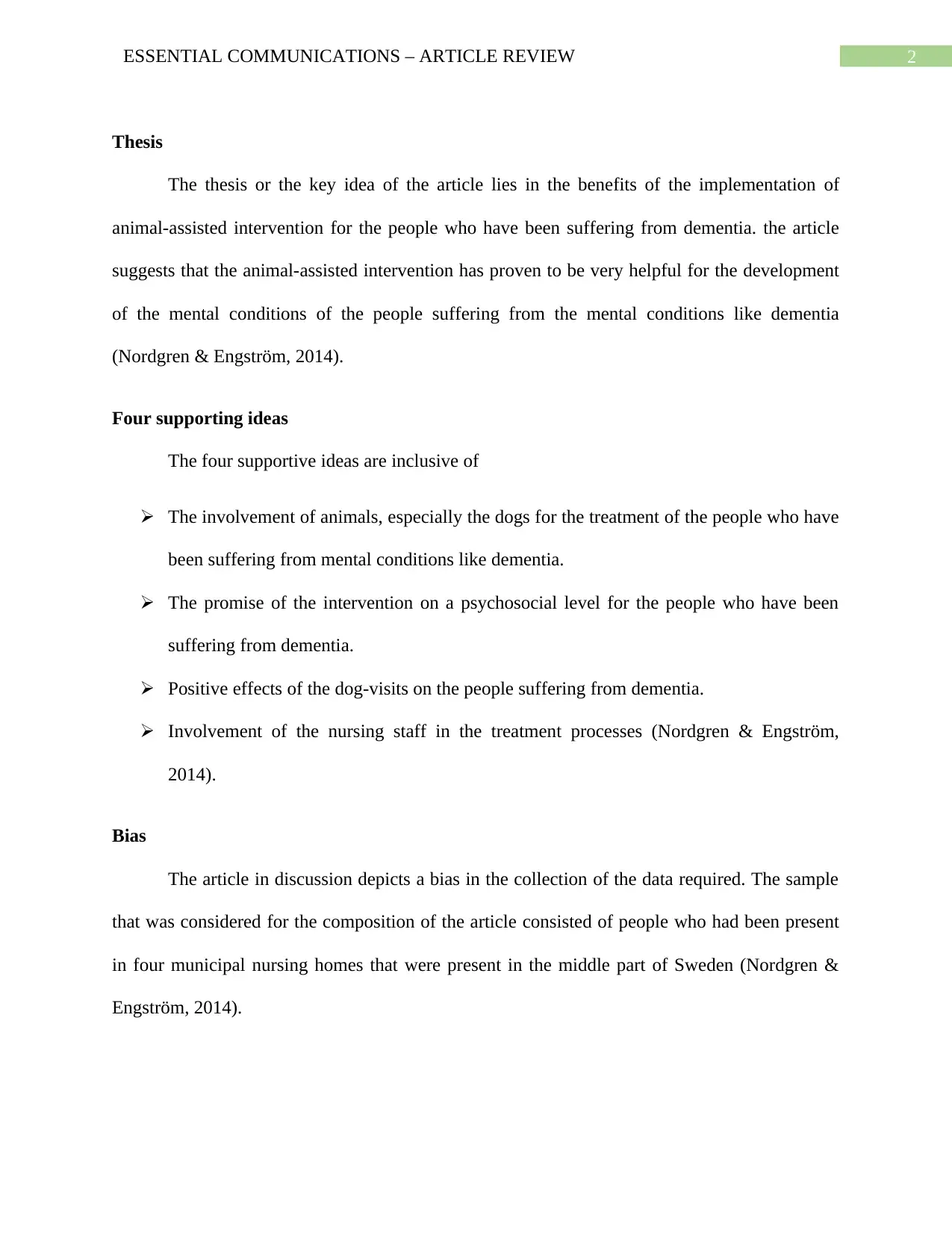
2ESSENTIAL COMMUNICATIONS – ARTICLE REVIEW
Thesis
The thesis or the key idea of the article lies in the benefits of the implementation of
animal-assisted intervention for the people who have been suffering from dementia. the article
suggests that the animal-assisted intervention has proven to be very helpful for the development
of the mental conditions of the people suffering from the mental conditions like dementia
(Nordgren & Engström, 2014).
Four supporting ideas
The four supportive ideas are inclusive of
The involvement of animals, especially the dogs for the treatment of the people who have
been suffering from mental conditions like dementia.
The promise of the intervention on a psychosocial level for the people who have been
suffering from dementia.
Positive effects of the dog-visits on the people suffering from dementia.
Involvement of the nursing staff in the treatment processes (Nordgren & Engström,
2014).
Bias
The article in discussion depicts a bias in the collection of the data required. The sample
that was considered for the composition of the article consisted of people who had been present
in four municipal nursing homes that were present in the middle part of Sweden (Nordgren &
Engström, 2014).
Thesis
The thesis or the key idea of the article lies in the benefits of the implementation of
animal-assisted intervention for the people who have been suffering from dementia. the article
suggests that the animal-assisted intervention has proven to be very helpful for the development
of the mental conditions of the people suffering from the mental conditions like dementia
(Nordgren & Engström, 2014).
Four supporting ideas
The four supportive ideas are inclusive of
The involvement of animals, especially the dogs for the treatment of the people who have
been suffering from mental conditions like dementia.
The promise of the intervention on a psychosocial level for the people who have been
suffering from dementia.
Positive effects of the dog-visits on the people suffering from dementia.
Involvement of the nursing staff in the treatment processes (Nordgren & Engström,
2014).
Bias
The article in discussion depicts a bias in the collection of the data required. The sample
that was considered for the composition of the article consisted of people who had been present
in four municipal nursing homes that were present in the middle part of Sweden (Nordgren &
Engström, 2014).
⊘ This is a preview!⊘
Do you want full access?
Subscribe today to unlock all pages.

Trusted by 1+ million students worldwide
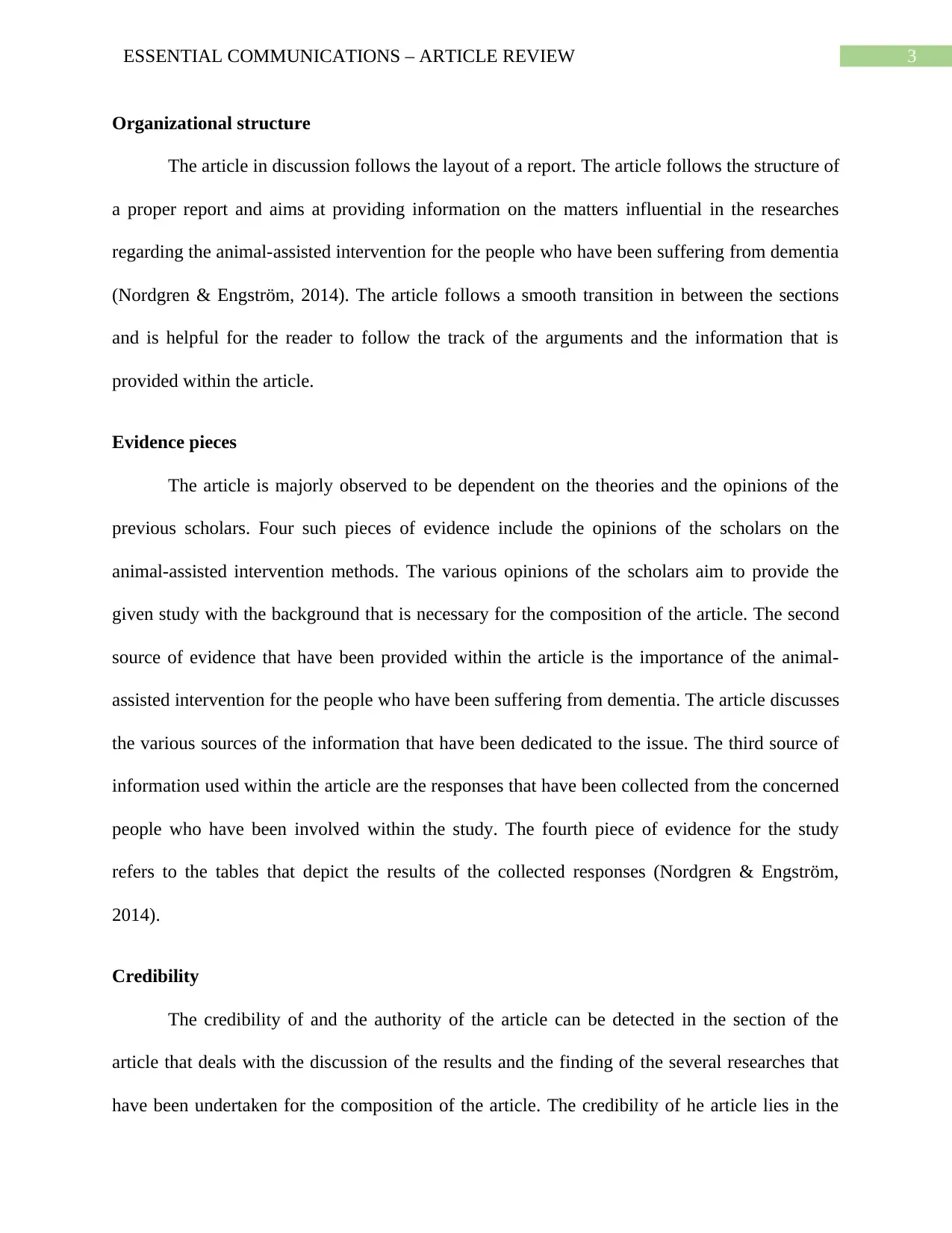
3ESSENTIAL COMMUNICATIONS – ARTICLE REVIEW
Organizational structure
The article in discussion follows the layout of a report. The article follows the structure of
a proper report and aims at providing information on the matters influential in the researches
regarding the animal-assisted intervention for the people who have been suffering from dementia
(Nordgren & Engström, 2014). The article follows a smooth transition in between the sections
and is helpful for the reader to follow the track of the arguments and the information that is
provided within the article.
Evidence pieces
The article is majorly observed to be dependent on the theories and the opinions of the
previous scholars. Four such pieces of evidence include the opinions of the scholars on the
animal-assisted intervention methods. The various opinions of the scholars aim to provide the
given study with the background that is necessary for the composition of the article. The second
source of evidence that have been provided within the article is the importance of the animal-
assisted intervention for the people who have been suffering from dementia. The article discusses
the various sources of the information that have been dedicated to the issue. The third source of
information used within the article are the responses that have been collected from the concerned
people who have been involved within the study. The fourth piece of evidence for the study
refers to the tables that depict the results of the collected responses (Nordgren & Engström,
2014).
Credibility
The credibility of and the authority of the article can be detected in the section of the
article that deals with the discussion of the results and the finding of the several researches that
have been undertaken for the composition of the article. The credibility of he article lies in the
Organizational structure
The article in discussion follows the layout of a report. The article follows the structure of
a proper report and aims at providing information on the matters influential in the researches
regarding the animal-assisted intervention for the people who have been suffering from dementia
(Nordgren & Engström, 2014). The article follows a smooth transition in between the sections
and is helpful for the reader to follow the track of the arguments and the information that is
provided within the article.
Evidence pieces
The article is majorly observed to be dependent on the theories and the opinions of the
previous scholars. Four such pieces of evidence include the opinions of the scholars on the
animal-assisted intervention methods. The various opinions of the scholars aim to provide the
given study with the background that is necessary for the composition of the article. The second
source of evidence that have been provided within the article is the importance of the animal-
assisted intervention for the people who have been suffering from dementia. The article discusses
the various sources of the information that have been dedicated to the issue. The third source of
information used within the article are the responses that have been collected from the concerned
people who have been involved within the study. The fourth piece of evidence for the study
refers to the tables that depict the results of the collected responses (Nordgren & Engström,
2014).
Credibility
The credibility of and the authority of the article can be detected in the section of the
article that deals with the discussion of the results and the finding of the several researches that
have been undertaken for the composition of the article. The credibility of he article lies in the
Paraphrase This Document
Need a fresh take? Get an instant paraphrase of this document with our AI Paraphraser
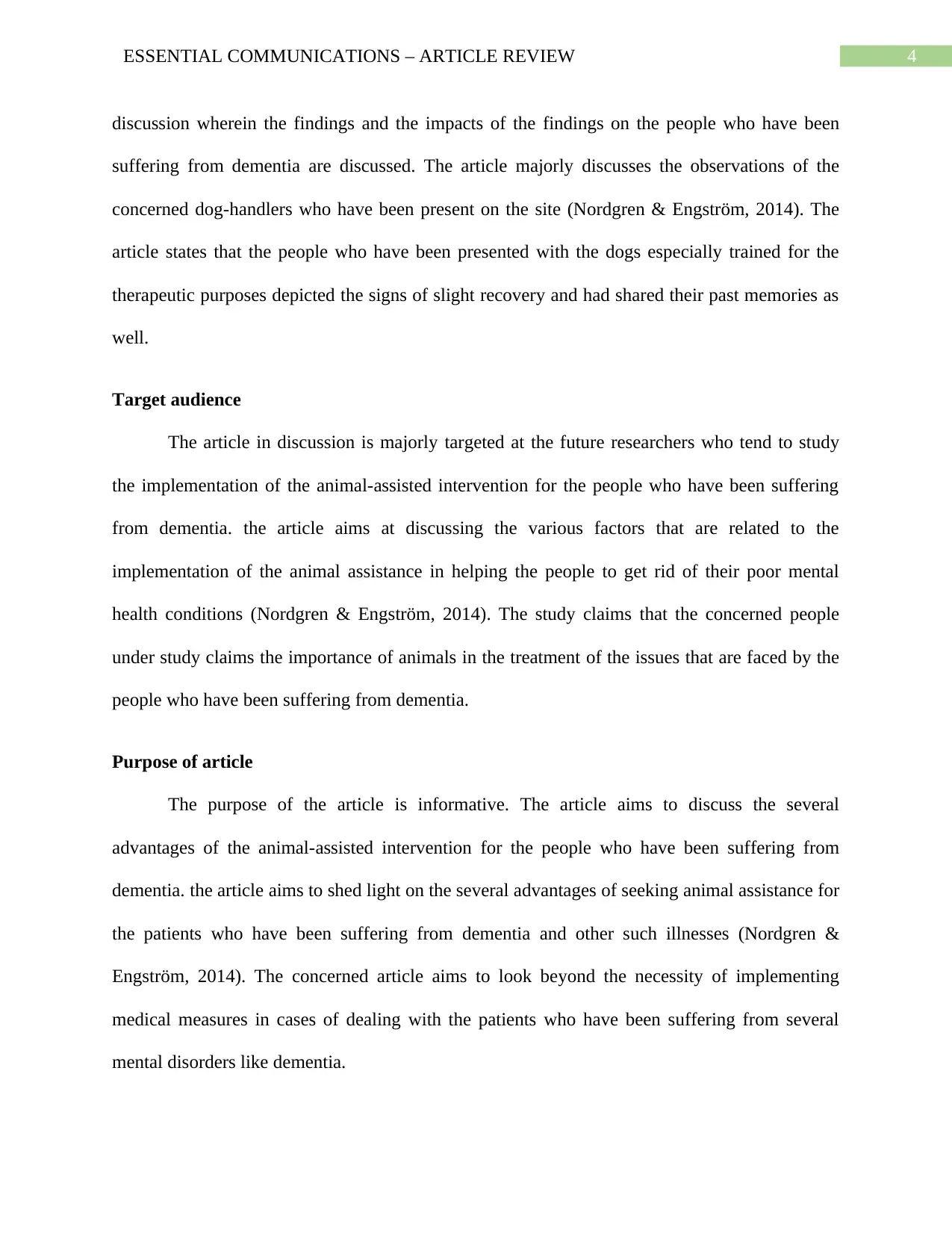
4ESSENTIAL COMMUNICATIONS – ARTICLE REVIEW
discussion wherein the findings and the impacts of the findings on the people who have been
suffering from dementia are discussed. The article majorly discusses the observations of the
concerned dog-handlers who have been present on the site (Nordgren & Engström, 2014). The
article states that the people who have been presented with the dogs especially trained for the
therapeutic purposes depicted the signs of slight recovery and had shared their past memories as
well.
Target audience
The article in discussion is majorly targeted at the future researchers who tend to study
the implementation of the animal-assisted intervention for the people who have been suffering
from dementia. the article aims at discussing the various factors that are related to the
implementation of the animal assistance in helping the people to get rid of their poor mental
health conditions (Nordgren & Engström, 2014). The study claims that the concerned people
under study claims the importance of animals in the treatment of the issues that are faced by the
people who have been suffering from dementia.
Purpose of article
The purpose of the article is informative. The article aims to discuss the several
advantages of the animal-assisted intervention for the people who have been suffering from
dementia. the article aims to shed light on the several advantages of seeking animal assistance for
the patients who have been suffering from dementia and other such illnesses (Nordgren &
Engström, 2014). The concerned article aims to look beyond the necessity of implementing
medical measures in cases of dealing with the patients who have been suffering from several
mental disorders like dementia.
discussion wherein the findings and the impacts of the findings on the people who have been
suffering from dementia are discussed. The article majorly discusses the observations of the
concerned dog-handlers who have been present on the site (Nordgren & Engström, 2014). The
article states that the people who have been presented with the dogs especially trained for the
therapeutic purposes depicted the signs of slight recovery and had shared their past memories as
well.
Target audience
The article in discussion is majorly targeted at the future researchers who tend to study
the implementation of the animal-assisted intervention for the people who have been suffering
from dementia. the article aims at discussing the various factors that are related to the
implementation of the animal assistance in helping the people to get rid of their poor mental
health conditions (Nordgren & Engström, 2014). The study claims that the concerned people
under study claims the importance of animals in the treatment of the issues that are faced by the
people who have been suffering from dementia.
Purpose of article
The purpose of the article is informative. The article aims to discuss the several
advantages of the animal-assisted intervention for the people who have been suffering from
dementia. the article aims to shed light on the several advantages of seeking animal assistance for
the patients who have been suffering from dementia and other such illnesses (Nordgren &
Engström, 2014). The concerned article aims to look beyond the necessity of implementing
medical measures in cases of dealing with the patients who have been suffering from several
mental disorders like dementia.
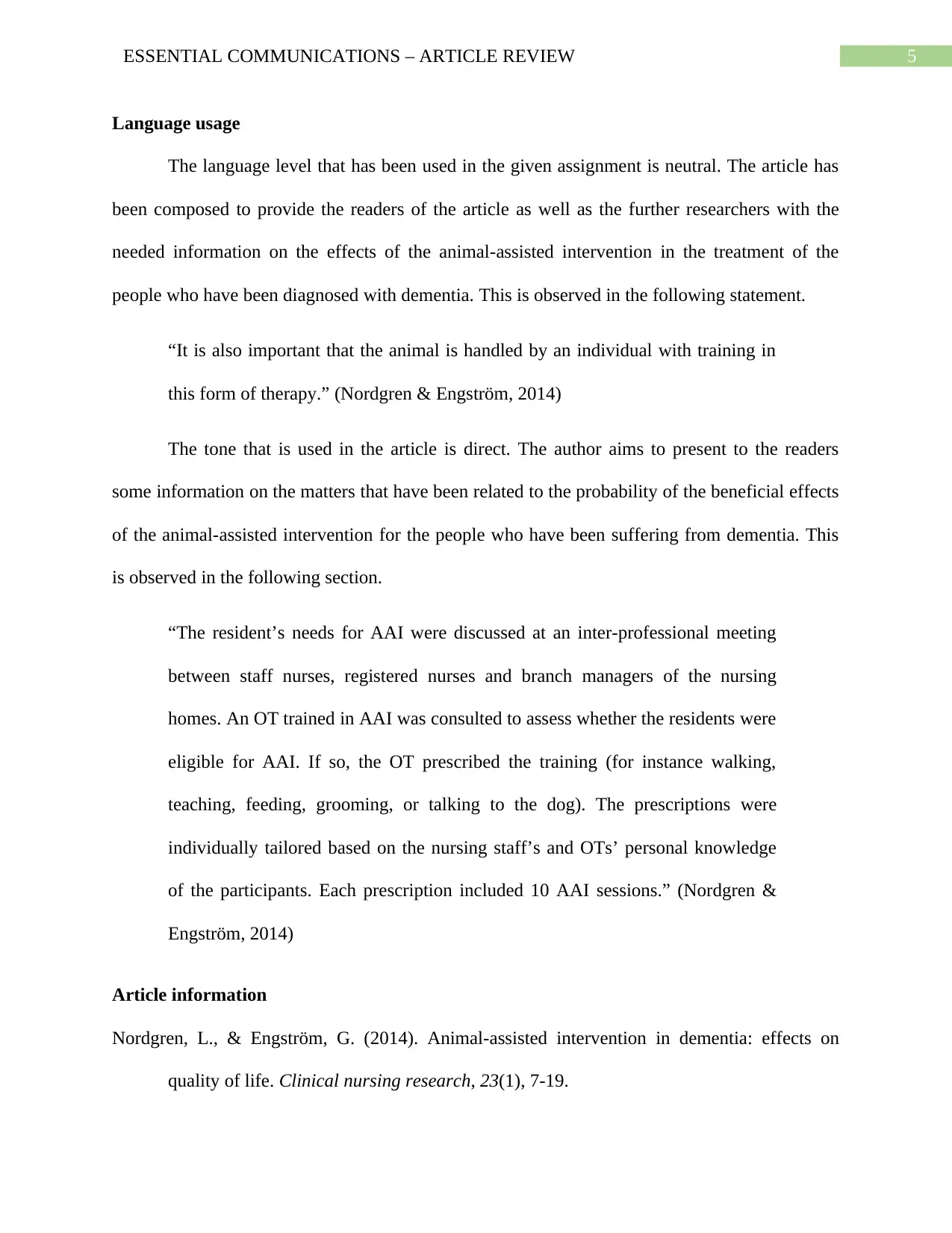
5ESSENTIAL COMMUNICATIONS – ARTICLE REVIEW
Language usage
The language level that has been used in the given assignment is neutral. The article has
been composed to provide the readers of the article as well as the further researchers with the
needed information on the effects of the animal-assisted intervention in the treatment of the
people who have been diagnosed with dementia. This is observed in the following statement.
“It is also important that the animal is handled by an individual with training in
this form of therapy.” (Nordgren & Engström, 2014)
The tone that is used in the article is direct. The author aims to present to the readers
some information on the matters that have been related to the probability of the beneficial effects
of the animal-assisted intervention for the people who have been suffering from dementia. This
is observed in the following section.
“The resident’s needs for AAI were discussed at an inter-professional meeting
between staff nurses, registered nurses and branch managers of the nursing
homes. An OT trained in AAI was consulted to assess whether the residents were
eligible for AAI. If so, the OT prescribed the training (for instance walking,
teaching, feeding, grooming, or talking to the dog). The prescriptions were
individually tailored based on the nursing staff’s and OTs’ personal knowledge
of the participants. Each prescription included 10 AAI sessions.” (Nordgren &
Engström, 2014)
Article information
Nordgren, L., & Engström, G. (2014). Animal-assisted intervention in dementia: effects on
quality of life. Clinical nursing research, 23(1), 7-19.
Language usage
The language level that has been used in the given assignment is neutral. The article has
been composed to provide the readers of the article as well as the further researchers with the
needed information on the effects of the animal-assisted intervention in the treatment of the
people who have been diagnosed with dementia. This is observed in the following statement.
“It is also important that the animal is handled by an individual with training in
this form of therapy.” (Nordgren & Engström, 2014)
The tone that is used in the article is direct. The author aims to present to the readers
some information on the matters that have been related to the probability of the beneficial effects
of the animal-assisted intervention for the people who have been suffering from dementia. This
is observed in the following section.
“The resident’s needs for AAI were discussed at an inter-professional meeting
between staff nurses, registered nurses and branch managers of the nursing
homes. An OT trained in AAI was consulted to assess whether the residents were
eligible for AAI. If so, the OT prescribed the training (for instance walking,
teaching, feeding, grooming, or talking to the dog). The prescriptions were
individually tailored based on the nursing staff’s and OTs’ personal knowledge
of the participants. Each prescription included 10 AAI sessions.” (Nordgren &
Engström, 2014)
Article information
Nordgren, L., & Engström, G. (2014). Animal-assisted intervention in dementia: effects on
quality of life. Clinical nursing research, 23(1), 7-19.
⊘ This is a preview!⊘
Do you want full access?
Subscribe today to unlock all pages.

Trusted by 1+ million students worldwide
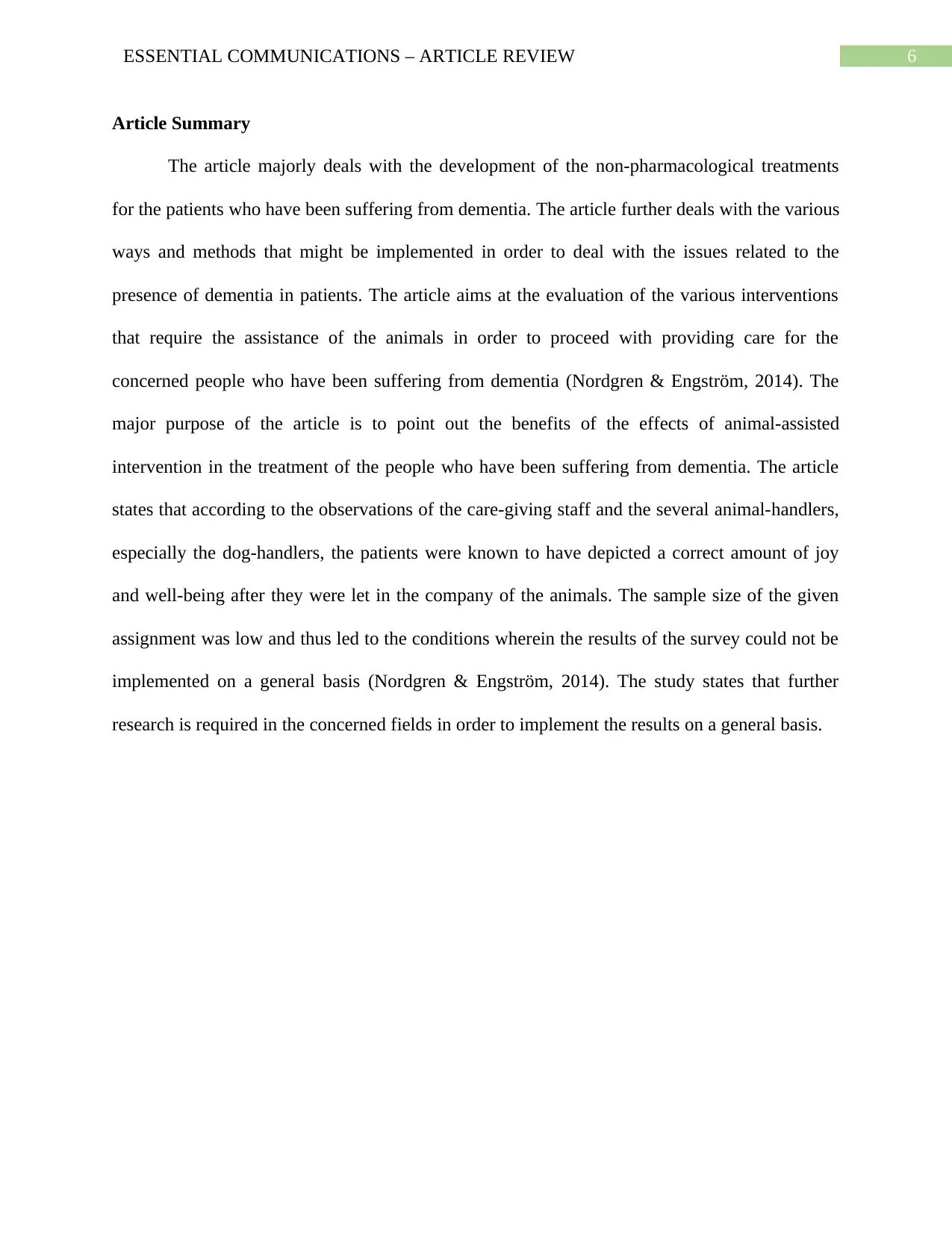
6ESSENTIAL COMMUNICATIONS – ARTICLE REVIEW
Article Summary
The article majorly deals with the development of the non-pharmacological treatments
for the patients who have been suffering from dementia. The article further deals with the various
ways and methods that might be implemented in order to deal with the issues related to the
presence of dementia in patients. The article aims at the evaluation of the various interventions
that require the assistance of the animals in order to proceed with providing care for the
concerned people who have been suffering from dementia (Nordgren & Engström, 2014). The
major purpose of the article is to point out the benefits of the effects of animal-assisted
intervention in the treatment of the people who have been suffering from dementia. The article
states that according to the observations of the care-giving staff and the several animal-handlers,
especially the dog-handlers, the patients were known to have depicted a correct amount of joy
and well-being after they were let in the company of the animals. The sample size of the given
assignment was low and thus led to the conditions wherein the results of the survey could not be
implemented on a general basis (Nordgren & Engström, 2014). The study states that further
research is required in the concerned fields in order to implement the results on a general basis.
Article Summary
The article majorly deals with the development of the non-pharmacological treatments
for the patients who have been suffering from dementia. The article further deals with the various
ways and methods that might be implemented in order to deal with the issues related to the
presence of dementia in patients. The article aims at the evaluation of the various interventions
that require the assistance of the animals in order to proceed with providing care for the
concerned people who have been suffering from dementia (Nordgren & Engström, 2014). The
major purpose of the article is to point out the benefits of the effects of animal-assisted
intervention in the treatment of the people who have been suffering from dementia. The article
states that according to the observations of the care-giving staff and the several animal-handlers,
especially the dog-handlers, the patients were known to have depicted a correct amount of joy
and well-being after they were let in the company of the animals. The sample size of the given
assignment was low and thus led to the conditions wherein the results of the survey could not be
implemented on a general basis (Nordgren & Engström, 2014). The study states that further
research is required in the concerned fields in order to implement the results on a general basis.
Paraphrase This Document
Need a fresh take? Get an instant paraphrase of this document with our AI Paraphraser

7ESSENTIAL COMMUNICATIONS – ARTICLE REVIEW
References
Nordgren, L., & Engström, G. (2014). Animal-assisted intervention in dementia: effects on
quality of life. Clinical nursing research, 23(1), 7-19.
References
Nordgren, L., & Engström, G. (2014). Animal-assisted intervention in dementia: effects on
quality of life. Clinical nursing research, 23(1), 7-19.
1 out of 8
Related Documents
Your All-in-One AI-Powered Toolkit for Academic Success.
+13062052269
info@desklib.com
Available 24*7 on WhatsApp / Email
![[object Object]](/_next/static/media/star-bottom.7253800d.svg)
Unlock your academic potential
Copyright © 2020–2025 A2Z Services. All Rights Reserved. Developed and managed by ZUCOL.





